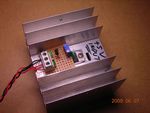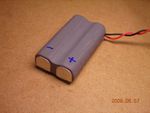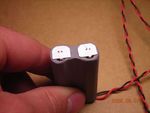

| ▲ Electronics |
I built and used this on my camera, and it worked happily, but you must use it at your own risk. Things can go wrong, components can fail, and who knows what the results would be. If you're planning on running your £200 brand new camera, then I would think again!
This is a simple 3V adjustable regulator. It operates on a 5V supply. I could've used a '317, which would have been much simpler, but I did't have one to hand. Improvise....
T1 is held normally on by R1. R2 divides down the output voltage and feeds it to the base of Q1. When Q1's base is above 0.6V, it turns on and pulls T1's base to ground, turning it off and reducing the output voltage. The net result is that the output voltage is adjusted such that Q1's base is 0.6V. By adjusting R2, the output can be changed.

T1 is a TO-220 case and needs to be heatsinked, as the camera draws around 0.8A. If the input voltage is 5V, then T1 is dropping around 2V, hence power dissipation is about 2W.
It's all assembled on a small piece of stripboard, with T1 screwed to a heatsink. Photo below.
 |
Such a large heatsink is probably overkill, but it makes a decent thing to lug around with the camera. The power connections are via a 3-way terminal block at one end.
The trickiest part was actually making a dummy battery to fit the camera. After much trial & error, I cut, filed, sanded a piece of PVC sheet into the shape of 2 AA batteries. I then drilled two holes lengthwise for the wires. These were soldered to two little pieces of silver sheet superglued to the end to serve as the contacts. Look at the photos - this explains it.
 |
 |
The camera says it will run from 2.4 to 3.0 volts, so I set the output of the regulator at 2.8V to be on the safe side.
The camera runs perfectly happily, and I've recorded some long (15min) videos with it without any problems. The heatsink on the regulator barely gets warm.
22/03/11 New 3V supply I built a better, mains-powered version of this supply - check it out.
| ▲ Electronics |